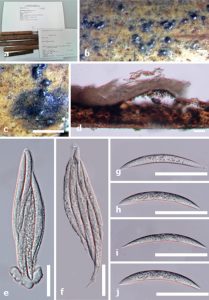Frondisphaeria palmicola K.D. Hyde, Mycoscience 37(2): 169 (1996), Index Fungorum number: IF 416017
Saprobic on rachis of Eugeissona minor Griff. Sexual morph: Ascomata 1000–1800 × 170–260 µm (x̄ = 1574 × 2256 μm, n = 10), immersed, visible as irregularly arranged, conical to dome-shaped areas, solitary or clustered, light brown, carbonaceous, in cross section irregularly rectangular, with tapered ends. Ostioles central, inconspicuous, periphysate, black. Peridium 30–50 µm (x̄ = 41.5 μm, n = 10) wide, outwardly comprising loosely arranged, flattened, light brown-grey cells, inwardly comprising thin-walled, compressed, dark brown cells. Hamathecium comprising numerous, filamentous, septate, paraphyses, 5 µm wide at base, with tapered ends. Asci 155–230 × 22–30 µm (x̄ = 173 × 27.6 μm, n = 20), 8-spored, unitunicate, clavate, narrow at the apex, pedicellate, with inconspicuous, J+, discoid, 2–4 × 1–2 µm (x̄ = 3.3 × 1.6 μm, n = 20) apical apparatus. Ascospores 80–110 × 7.5–10 µm (x̄ = 91 × 8.6 μm, n = 20), crowded, unicellular, hyaline, long-fusiform, slightly curved at the ends, smooth-walled. Asexual morph: Undetermined.
Material examined: BRUNEI, on rachis of Eugeissona minor Griff., June 1993, K.D. Hyde, BRIP 23235 (holotype)
Fig. 1. Frondisphaeria palmicola (holotype) a Herbarium package. b, c Stromata in wood. d Cross section of stromata showing ascomata encased in stromatal tissue. e Mature asci in water. f Asci with apical apparatus bluing in Melzer’s reagent. g–j Ascospores. Scale bars: b = 5 mm, c = 3 mm, d = 100 µm e, f = 20 µm, g–j = 50 µm.

